|

19 March 2008
from
BBC Website
The imagination of the science fiction
author Sir
Arthur C. Clarke bubbled over
with ideas about the future of science, technology and human
society.
Here, BBC science and technology
staff look at some that came true, and some that did not.
1. SPACE
ELEVATOR
A space elevator consists of a ribbon of material strung between a
spacecraft and an anchor on Earth. The tether would be used to
transport material from Earth into space.
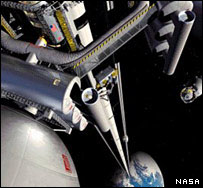
Space
elevators would link Earth to objects in geostationary orbit
Sir Arthur first talked about the concept in his 1979 novel The
Fountains of Paradise, in which engineers construct a space
elevator on top of a mountain peak on a fictional island.
He embellished these concepts in his 1981 technical paper
The Space Elevator: Thought Experiment, or Key
to the Universe? Although he brought the concept of a
space elevator to a wider audience, the idea was first conceived by
Russian scientist Konstantin Tsiolkovsky in 1895.
The idea may sound like it should remain in the realm of science
fiction, but many take it seriously.
NASA has had a long-running space elevator research project, and
recent developments with carbon
nano-tubes have raised the
possibility of developing a tether strong enough to connect a ship
to Earth - previously one of the key challenges.
For the last three years there has even been a competition, run by
the Elevator:2010 project, which awards prizes of $500,000 to
help develop the technology.
2. MILLENNIUM
BUG
The millennium bug gripped governments and businesses as the
countdown to the year 2000 began.
The
Y2K bug, as it was also known,
referred to potential problems arising from older computer systems
that could not recognize 2000 as the year coming after 1999.
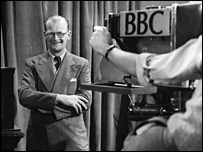
Some of Sir
Arthur's predictions date back to the 1950s
People were warned not to fly over the New Year, and were told that
there could be potential problems with banking and even gas and
electricity supplies. In interviews, Sir Arthur said he outlined
what may have been,
"the first account, outside the
technical literature, of the now-dreaded millennium bug, its
cause and its cure."
The prediction was made in a chapter of
his 1990 novel The Ghost from the Grand Banks.
In the end, the Y2K bug had little effect on businesses as the
clocks struck midnight.
3. SPACE
GUARD
This Clarke prediction not only came true, it did so with the name
that he bestowed in his 1972 novel Rendezvous with Rama.
The eponymous rendezvous occurs in 2131, when astronomers
working with Project Spaceguard, Earth's defence system
against asteroid strikes, detect an alien probe hurtling towards the
Solar System.
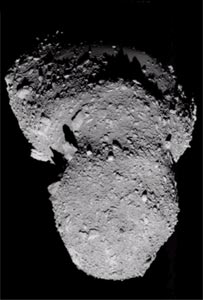
The Hayabusa
probe landed on the potato-shaped asteroid Itokawa
Alien probes may not be frequent visitors in reality, but
asteroids and meteorites are; hence
a 1992 NASA investigation into how to monitor these visiting bodies
and assess the threat they may pose.
It was named the Spaceguard Survey. The primary aim of US
policy now is to map 90% of Near Earth Objects (NEOs).
Britain also has a national information service for NEOs, although
lobby groups such as - you guessed it - Spaceguard UK would like the
government to commit more resources to the issue.
In The Hammer of God, Sir Arthur envisaged that a rogue
asteroid could be deflected from its Earth-bound course by landing
on it and fitting thrusters.
In 2005 the Japanese
Hayabusa probe did land on asteroid
Itokawa, though deploying thrusters and attempting a deflection is
still science fiction.
4.
COMMUNICATIONS SATELLITES
Arthur C. Clarke was not the first to suggest using geostationary
orbits - his ideas built on earlier work by Herman Potocnik
and Konstantin Tsiolkovsky.
His conceptual leap, outlined in a 1945 article in Wireless World
magazine, was to propose using a set of satellites in
geostationary orbit to form a global communications network.
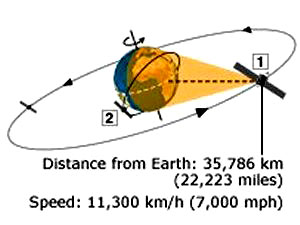
Graphic of
orbits
Image: BBC
1. Geostationary
satellites "parked" over equator travel at same direction
and speed as Earth revolves. Each "footprint" covers 40% of
globe. Directional antennae are aimed and fixed in position
with no need for tracking
2. Satellites at lower orbits must travel faster than Earth
revolves to avoid being pulled out of orbit by gravity, so
they need tracking. Many do not follow an equatorial path
The key property of a satellite orbiting
precisely 35,786 km (22,240 miles) above the equator is its speed,
which mimics the rotation of the Earth below. So it remains always
over the same place.
The first satellite was placed into geostationary orbit in 1964,
just 19 years after Sir Arthur's paper. Syncom 3 orbited above the
Pacific Ocean and beamed pictures from the Tokyo Olympics to the US
later that year - the first trans-Pacific TV transmission.
Networks of satellites in this orbit now provide services including
phone calls, data transmission, and TV signals for most of the
world's inhabited regions.
Meteorological and ground observation satellites also follow the
path Sir Arthur mapped out, and the term Clarke Orbit is
sometimes used to describe their trajectory.
What he did not foresee was the development of the transistor and
later the integrated circuit, which mean satellites are far smaller
than the objects he sketched out, which would have used valve
technology and needed regular maintenance.
5. ATOMIC
TRAVEL
Prelude to Space was not only Arthur C. Clarke's first
published science fiction novel, it was the prelude to a career that
produced a number of suggestions about how humankind might journey
into space.
The 1951 book envisaged bringing nuclear energy into use, powering a
craft named Prometheus.
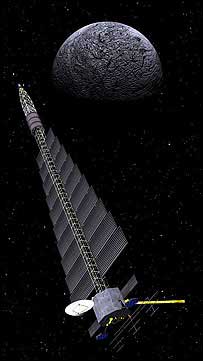
Nasa's Jimo
concept would have sent nuclear power into space
Arguably the author was out-imagined by US planners in the early
days of the Cold War, whose
Project Orion concept involved
craft propelled by detonating a series of nuclear bombs behind them.
Orion did not get off the ground; but life eventually imitated Sir
Arthur's art in the Soviet Union, which launched a number of
satellites powered by nuclear reactors.
Cosmos 954 crashed in Canada
in 1978, with contamination of the surrounding area.
NASA revived the nuclear concept a few years ago with
Project Prometheus, a research
initiative that would have sent nuclear-powered probes out to
explore the cosmos.
Its most heralded component was the Jupiter Icy Moons Orbiter
(Jimo),
which would use its huge power source to zoom from one exciting
Jovian satellite to the next looking for water and life.
But NASA's Prometheus has died; and there is little sign of any
space agency taking the nuclear option further.
6.
EARTHQUAKE PREVENTION
In Richter 10, his 1990 collaboration with science fiction
author Mike McQuay, Sir Arthur tells the story of an
attempt to predict and prevent earthquakes.
The plan is to "spot weld" the earth's tectonic plates at 50
strategic locations, stopping their movement and therefore stopping
the catastrophic splits that cause earthquakes.
The welding was to be done by detonating powerful nuclear bombs deep
inside the Earth.
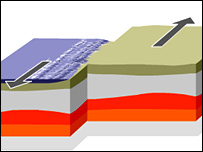
How
earthquakes happen
The plan is initiated to prevent a huge quake splitting California
from the North American mainland. At the moment this scenario
remains almost completely in science fiction.
Earthquake prediction is an inexact science with no standard,
reproducible technique used by scientists. In addition, tectonic
forces are huge, able to build mountains, create deep ocean basins
and tear continents apart.
"Spot welding" an earthquake fault would probably have very little
long term effect when pitted against these monstrous movements.
In any case, the plan outlined in Richter 10 is foiled when a
terrorist attack destroys the facility where the work is being
carried out.
7. BRAIN
BACKUP
Sir Arthur often explored the idea of backing up or transferring the
human brain on to a computer.
In his book 3001: The Final Odyssey he wrote of future
beings:
"As soon as their machines were
better than their bodies, it was time to move."
"First their brains, and then their thoughts alone, they
transferred into shining new homes of metal and of gemstone."
"In these they roamed the galaxy. They no longer built
spaceships - they were spaceships"
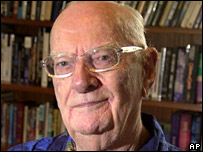
Radio Four
Sir Arthur C Clarke - Science and Fiction
It was an idea he thought would be useful for people wanting to pass
their memories and personalities on at the end of their lives.
"When their bodies begin to
deteriorate you transfer their thoughts so their personalities
would be immortal," he told the BBC in 2005. "Just save it on a
CD-Rom and plug it in - simple!"
Although scientists have not quite
reached this stage yet, projects are starting to lay the
foundations.
For example Gordon Bell, a researcher at Microsoft, is
working on a project called
MyLifeBits which aims to
digitally store,
"a lifetime's worth of articles,
books, cards, CDs, letters, memos, papers, photos, pictures,
presentations, home movies, videotaped lectures, and voice
recordings"
The latest version of the project also
allows him to capture phone calls, instant messenger transcripts,
television, and radio to build up a virtual surrogate memory of his
life.
8. PEOPLE
FREEZING
Arthur C. Clarke's preoccupation with interplanetary space travel
led him to consider how humans could survive for the long periods
needed to cross vast tracts of space.
One of the answers he came up with, outlined in the story The
Songs of Distant Earth, was cryogenic suspension.
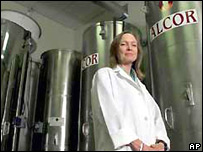
Cryogenic
storage still has a number of issues to overcome
The plot sees the human race having to leave Earth in a convoy of
spaceships as the Sun is about to explode.
Currently,
cryogenic preservation of living people is impossible,
and in many countries it is illegal to attempt it. More than 150
people, mainly in the US, have been frozen in liquid nitrogen after
their death.
But even the companies running these projects admit that freezing
cannot be reversed and there is no proof that it would preserve
peoples' identities, even though there is evidence that brain
structure can survive the process.
In medicine, very cold conditions are used to store organs before
transplantation and to store eggs and sperm, and as a way of
removing warts.
|








